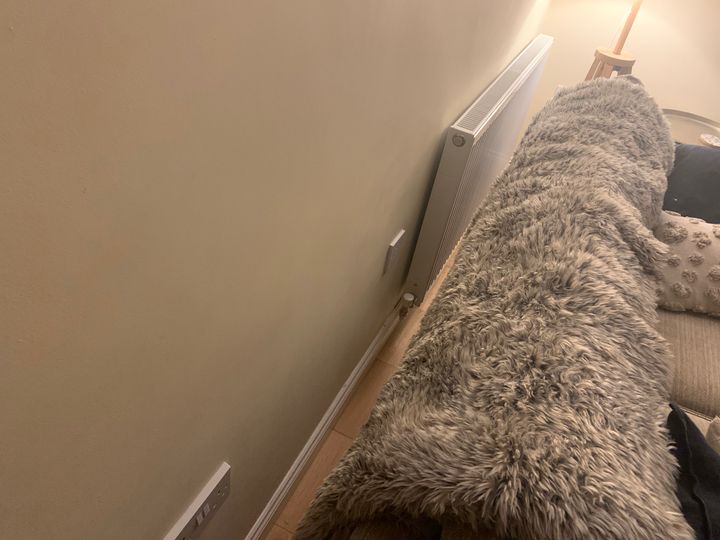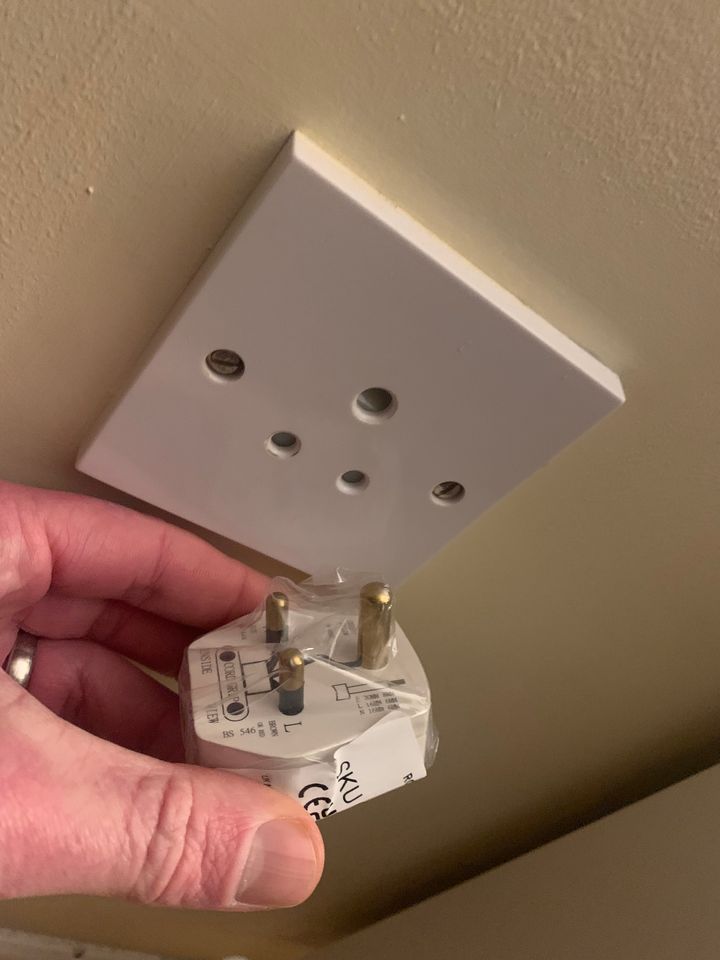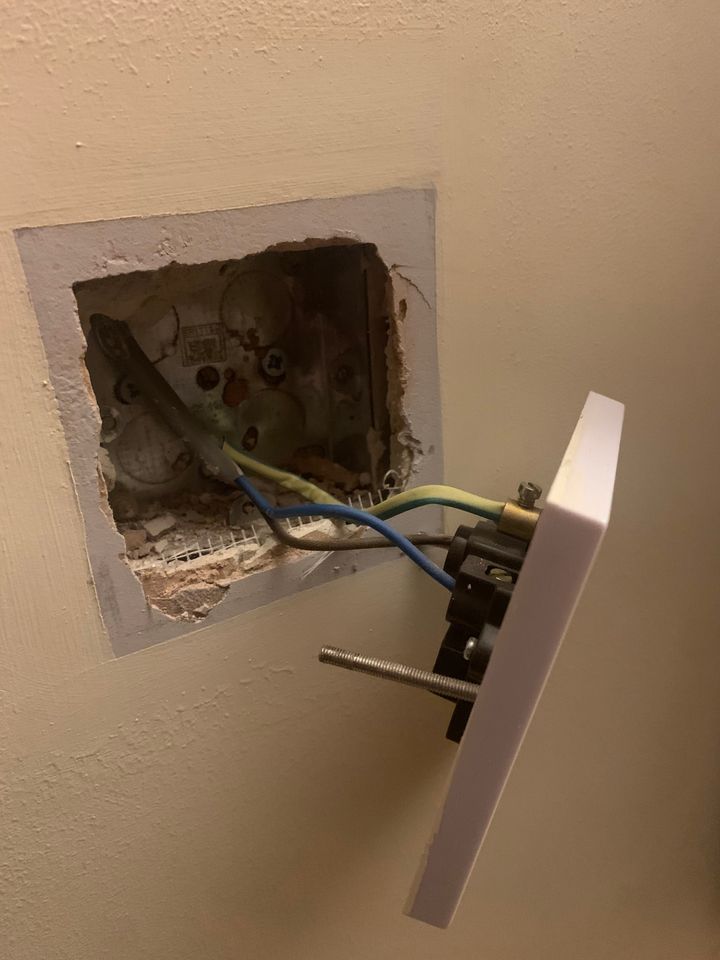Round 3 pin sockets
Discussion
Recently moved into a house which the main switch as you walk in switches a socket to live, the socket is 3 round pins so I’m guessing was for a lamp?
I’ve picked up a socket from screwfix and just checking I can just rewire the lamp wire into this socket?
Only concern is the plug is non fused.
Hopefully the pictures help.




I’ve picked up a socket from screwfix and just checking I can just rewire the lamp wire into this socket?
Only concern is the plug is non fused.
Hopefully the pictures help.
I have the same things in our living room. Never used them and just use normal adjacent sockets (with smart plugs). Google says about 5 Amp sockets:
5 amp lamp sockets are designed for low-power lighting applications.
They are switched on and off with room light switches.
They are not suitable for larger appliances.
5 amp lamp sockets are designed for low-power lighting applications.
They are switched on and off with room light switches.
They are not suitable for larger appliances.
I think OP means he has picked up a suitable round pin plug from Screwfix.
These sockets are indeed for lamps and are normally rated 5amps. The idea is to leave the lamp plugged in and permanently on if there is an inline switch on the flex and to control the lamp from the wall switch.
To the OP - yes, just replace the regular plug with the round pin one you have purchased and all will be fine (assuming it is indeed a lamp you are connecting).
These sockets are indeed for lamps and are normally rated 5amps. The idea is to leave the lamp plugged in and permanently on if there is an inline switch on the flex and to control the lamp from the wall switch.
To the OP - yes, just replace the regular plug with the round pin one you have purchased and all will be fine (assuming it is indeed a lamp you are connecting).
Edited by Mark V GTD on Saturday 21st December 19:16
Sorry my fault for not explaining, we want to just be able to use the wall switch to turn the corner lamp on/off.
So swap the plug on the lamp for the round plug and keep light switch on the lamp on and all should be fine. The wiring is a spur my quick google is an unfused plug is fine off a spur but not a ring main.
It’s crazy as there’s no actual ceiling light, didn’t notice on viewing, night of moving in turn the big light on Errm there isn’t one….
So swap the plug on the lamp for the round plug and keep light switch on the lamp on and all should be fine. The wiring is a spur my quick google is an unfused plug is fine off a spur but not a ring main.
It’s crazy as there’s no actual ceiling light, didn’t notice on viewing, night of moving in turn the big light on Errm there isn’t one….
Edited by BertyFish on Saturday 21st December 20:04
Our house has some old 2A versions and some newer 5A versions.
They are on the lighting circuit which has a 6A breaker so fairly safe.
I prefer it to faffing with turning on table lamps individually.
But it's not the be-all and end-all of lighting.
I sometimes think it's time 240V lighting was consigned to history.
They are on the lighting circuit which has a 6A breaker so fairly safe.
I prefer it to faffing with turning on table lamps individually.
But it's not the be-all and end-all of lighting.
I sometimes think it's time 240V lighting was consigned to history.
silentbrown said:
Usually 2 amp, not 5? Brilliant things, so you can turn table lights on from a regular switch by the door.
They seem to have gone the way of the dinosaur, which is a real shame.
There are/were 3 sizes IIRC, 2, 5 and 15 amp. I think the bigger size is often found in theatrical lighting rigs.They seem to have gone the way of the dinosaur, which is a real shame.
silentbrown said:
Usually 2 amp, not 5? Brilliant things, so you can turn table lights on from a regular switch by the door.
They seem to have gone the way of the dinosaur, which is a real shame.
I grew up in a house with the 'old style' system. There were three kinds of round pin plugs:They seem to have gone the way of the dinosaur, which is a real shame.
3-pin 15A (big)
3-pin 5A (small)
2-pin 2A (small)
As mentioned above, 15A was for heaters, cookers etc, and 5A for lesser things like lighting - as was the 2A.
We also had the OP's set up of a table lamp plugged in to the wall, and a switch somewhere more convenient to operate it. It's just about making your house easier to use.
BertyFish said:
Sorry my fault for not explaining, we want to just be able to use the wall switch to turn the corner lamp on/off.
So swap the plug on the lamp for the round plug and keep light switch on the lamp on and all should be fine.
Yep. As it was intended!So swap the plug on the lamp for the round plug and keep light switch on the lamp on and all should be fine.
OutInTheShed said:
Our house has some old 2A versions and some newer 5A versions.
They are on the lighting circuit which has a 6A breaker so fairly safe.
I prefer it to faffing with turning on table lamps individually.
But it's not the be-all and end-all of lighting.
I sometimes think it's time 240V lighting was consigned to history.
240V lighting has been consigned to history....it's now 230V!They are on the lighting circuit which has a 6A breaker so fairly safe.
I prefer it to faffing with turning on table lamps individually.
But it's not the be-all and end-all of lighting.
I sometimes think it's time 240V lighting was consigned to history.
Pedant mode over....
BertyFish said:
Thanks, I was just worried if the plug should
Should have a fuse.
The fuse in a plug prevents the item's cable from becoming the fuse - so if you stick a 13A fuse in a plug for an item that has a thin cable, then the cable can melt if there's a fault. The main fuse/breaker will be 30A/32A so the circuit needs the downstream protection in the plug.Should have a fuse.
In the lighting case, the whole circuit would be protected in the old days by 5A fuse wire, or these days by a 6A breaker, so if there's a fault that'll blow/trip before the cable to the light melts.
BertyFish said:
It’s crazy as there’s no actual ceiling light, didn’t notice on viewing, night of moving in turn the big light on Errm there isn’t one….
It's by design. When you've got this wired up with a couple of table lights or floor lamps, you'll realize how unpleasant the light from ceiling lights can be!BertyFish said:
Sorry my fault for not explaining, we want to just be able to use the wall switch to turn the corner lamp on/off.
So swap the plug on the lamp for the round plug and keep light switch on the lamp on and all should be fine. The wiring is a spur my quick google is an unfused plug is fine off a spur but not a ring main.
It’s crazy as there’s no actual ceiling light, didn’t notice on viewing, night of moving in turn the big light on Errm there isn’t one….
The cabling will be on the lighting circuit (5 or 6 amp fuse or circuit breaker in the consumer unit) not the ring main which is 30 amp.So swap the plug on the lamp for the round plug and keep light switch on the lamp on and all should be fine. The wiring is a spur my quick google is an unfused plug is fine off a spur but not a ring main.
It’s crazy as there’s no actual ceiling light, didn’t notice on viewing, night of moving in turn the big light on Errm there isn’t one….
Edited by BertyFish on Saturday 21st December 20:04
Sheepshanks said:
we use ring circuits for sockets - everywhere else uses radials, so each socket (or sometimes room) has its own breaker.
Which makes a lot more sense, because if you keep adding 13 amp loads to a ring you'll soon make it pop.Johnny American runs at just 120v so has relatively huge currents (double) everywhere. Hence fat wires to almost everything and many appliances on their own circuits. On the other hand he doesn't need a plug the size of your fist for every table lamp...
Gassing Station | Homes, Gardens and DIY | Top of Page | What's New | My Stuff



